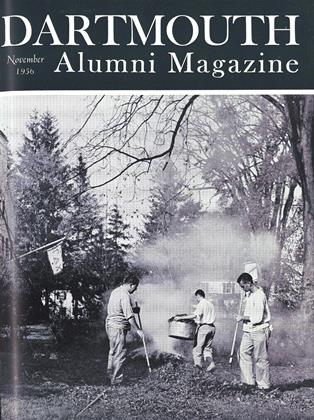Andrew J.Scarlett '10. New York: Henry Holt, 1956.499 pp. $5.00.
A new chemistry text which lives up to the high standard o£ excellence of the Richardson-Scarlett tradition has come off the presses. College Chemistry is based in part on BriefCollege Chemistry by the late Professor Richardson and Professor Scarlett, first published in 1942 and revised in 1951. Most of the text has been completely rewritten by Professor Scarlett. Fuller and more lucid discussions of fundamental principles permeate the book. Difficult topics and different types of problems are more evenly distributed. The section on hydrocarbon derivatives has been expanded. No attempt is made to cover all descriptive inorganic chemistry, yet most of the important industrial processes are described, and the chemistry of the simpler compounds of important elements is included. The relation between atomic structure and chemical properties is emphasized.
College Chemistry is intended primarily £or use in courses where time is limited. However, Professor Scarlett has made the approach to principles and to problems rigorous enough so that the book might well be used as the basic text in more extensive general college chemistry courses. It sows the seed for further amplification by the teacher. The omission of "brief" from the title is significant. The text is not brief or superficial, but rather concise and to the point. It is a text to be "studied," not merely "read." The book is exceptionally well done and serves a very definite need in the college chemistry field.
The appeal of this excellent text to teachers has been so great that it is now in its second printing, less than six months after the large first printing.
U. S. Naval Academy
 View Full Issue
View Full Issue
More From This Issue
-
 Feature
FeatureThe Poet as Teacher The Poet as Teacher
November 1956 By RICHARD EBERHART '26 -
 Feature
FeatureThe Convocation Address
November 1956 -
 Feature
FeatureFinancial Report for 1955-56
November 1956 -
 Feature
FeatureClub Officers Hold Conference
November 1956 -
 Class Notes
Class Notes1926
November 1956 By HERBERT H. HARWOOD, H. DONALD NORSTRAND, RICHARD M. NICHOLS -
 Class Notes
Class Notes1918
November 1956 By ERNEST H. EARLEY, W. CURTIS GLOVER, RICHARD P. WHITE
Books
-
 Books
BooksNorth of Boston
June, 1915 -
 Books
Books"Ruskin The Professor,"
December, 1928 -
 Books
BooksFaculty Publications
December 1948 -
 Books
BooksFaculty Articles
April 1956 -
 Books
BooksPOUNDITOUT.
April 1955 By CLIFF JORDAN '45 -
 Books
BooksACTING PROFESSIONALLY: RAW FACTS ABOUT ACTING AND THE ACTING BUSINESS.
NOVEMBER 1972 By ERIC FORSYTHE '69


